Samsung Galaxy S III Review - AT&T and T-Mobile USA Variants
by Brian Klug on June 20, 2012 12:01 AM ESTI was sampled both the AT&T and T-Mobile SGS3s, so I can really only speak to those particular variants. However, all five of the USA SGS3s use MSM8960’s onboard cellular baseband for their respective cellular interfaces. I’m including the table from our original MSM8960 piece almost a year ago, since that shows the capabilities of the baseband - of course, whether or not your device supports all these things is a function of the rest of the RF chain, including transceiver and power amplifiers.
| Snapdragon S4 - MSM8960 Cellular Support | |||||
| LTE FDD | 100 Mbps DL / 50 Mbps UL (Cat. 3, 3GPP Rel.9) | ||||
| LTE TDD | 68 Mbps DL / 17 Mbps UL (Cat. 3, 3GPP Rel.9) | ||||
| UMTS | DC-HSPA+ 42 Mbps DL (Cat. 24) / 11 Mbps UL (Cat. 8) | ||||
| CDMA2000 | 1xAdvanced, EVDO Rev.B (14.7 Mbps DL / 5.4 Mbps UL) | ||||
| GSM | GSM/GPRS/EDGE | ||||
| TD-SCDMA | TD-SCDMA 4.2 Mbps DL / 2.2 Mbps UL | ||||
In the case of the AT&T SGS3, that’s LTE on bands 17 and 4 as shown in the table below. What’s unique about the AT&T LTE SGS3 is that it’s the first device in the USA I’ve seen with support for both 15 and 20 MHz FDD-LTE on Band 4 (AWS). That should tell you something about the product development cycle here, specifically that the AT&T SGS3 was conceived of back when AT&T was confident about getting T-Mobile’s AWS holdings. In addition, all of the cellular connectivity on the AT&T SGS3 sits on the same transmit path, with transmit at the bottom and receive diversity up at the top.
| SGS3 AT&T - Network Support | |||||
| GSM/EDGE Support | 850 / 900 / 1800 / 1900 MHz | ||||
| WCDMA Support | 850 / 1900 / 2100 MHz | ||||
| LTE Support | 700 / 1700 MHz (LTE Band 17, 4), Category 3 | ||||
| Baseband Hardware | Qualcomm MSM8960 | ||||
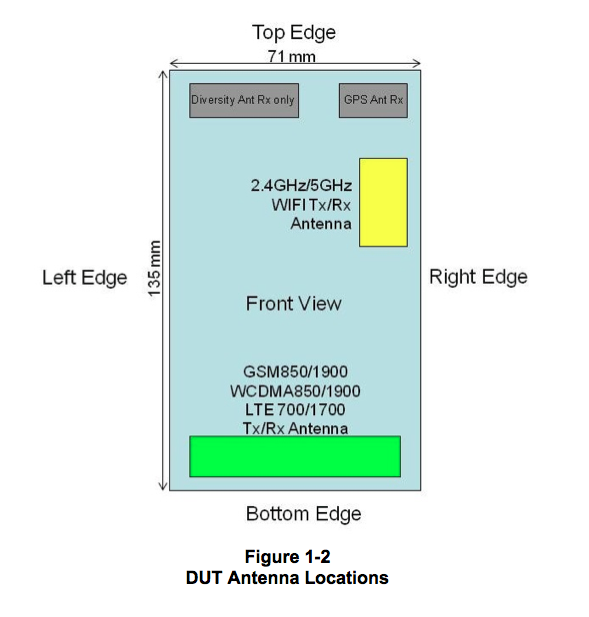
The T-Mobile SGS3 is unsurprisingly very similar to the AT&T SGS3, including support for both their own bands and AT&T’s bands for WCDMA as shown in the table below. The T-Mobile device of course supports WCDMA carrier aggregation, or DC-HSPA+. For those that aren’t familiar, DC-HSPA+ Category 24 (3GPP Rel.8) employes carrier aggregation in addition to the other HSPA+ features from Release 7. Essentially, two 5 MHz WCDMA carriers are aggregated together on the downlink, resulting in roughly double the performance of a single WCDMA carrier situation. Note that the uplink remains single carrier, so there’s even more of an asymmetry that happens, but given the traffic asymmetry that already exists for most mobile workloads this isn’t a huge deal.
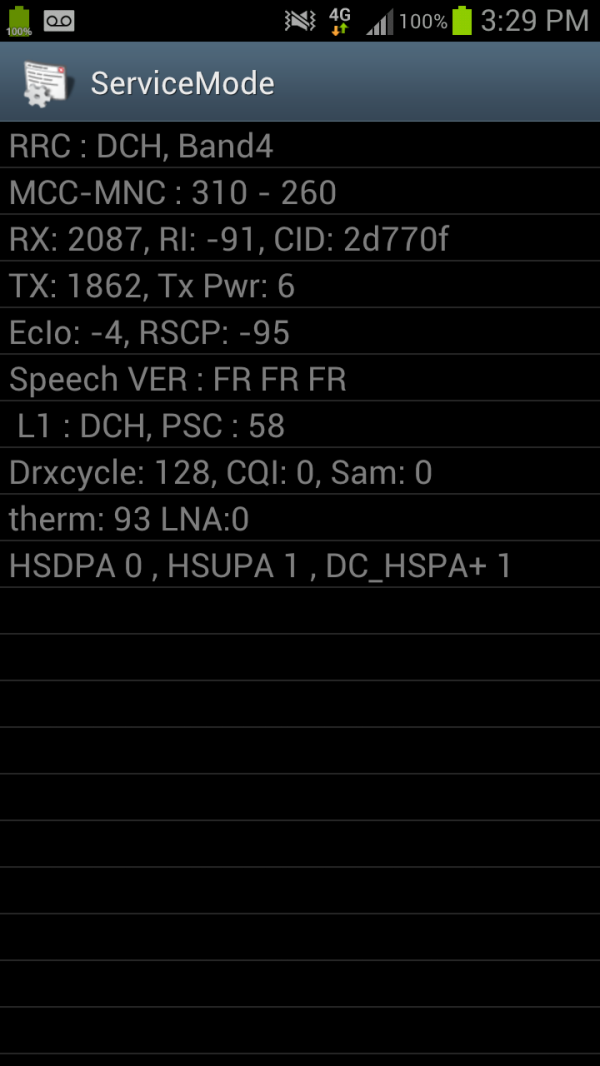
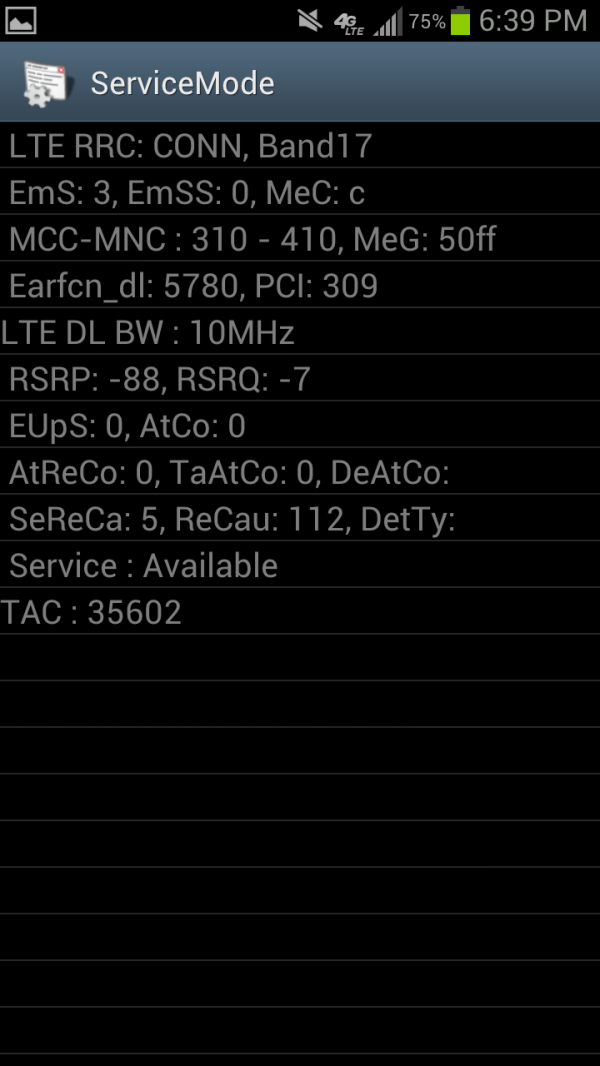
Samsung's excellent ServiceMode (*#0011#) is present on all the USA SGS3 variants, DC-HSPA+ shown on T-Mobile SGS 3 (left), 10 MHz FDD-LTE shown on AT&T Model (right)
Like the HTC One S, the T-Mobile SGS3 can be used on AT&T’s 3G network if you can manage to unlock one. This is a definite plus if you don’t care about LTE but do care about having a phone with a ton of WCDMA bands supported.
| SGS3 T-Mobile - Network Support | |||||
| GSM/EDGE Support | 850 / 900 / 1800 / 1900 MHz | ||||
| WCDMA Support | 850 / 1700 / 1900 / 2100 MHz | ||||
| HSPA Speeds | HSDPA 42.2 (Cat.24) / HSUPA 5.76 (Cat.6) | ||||
| Baseband Hardware | Qualcomm MSM8960 | ||||
Because of my limited time with the SGS3s, I haven’t had a chance to run a bunch of speedtests on AT&T LTE and report back with plots. In addition, because AT&T does not support DC-HSPA+ yet (and shows no indication of doing so), there’s not much to be learned from 3G WCDMA there, as it’s still just HSDPA 14.4 in my market and almost all others. I’ve still never seen a single AT&T market with 64QAM / HSDPA 21.1. I will update with AT&T LTE results when I have them.
I have however run a bunch on the T-Mobile in my home market of Tucson, AZ and compiled enough to generate some plots. To test, I used the same workflow as always, essentially running as many tests as possible using Ookla’s speedtest.net application on Android, exporting the results, and making some pretty graphs with python. I’ve rewritten my graphing code and prettied it up a bit as well with some stats.
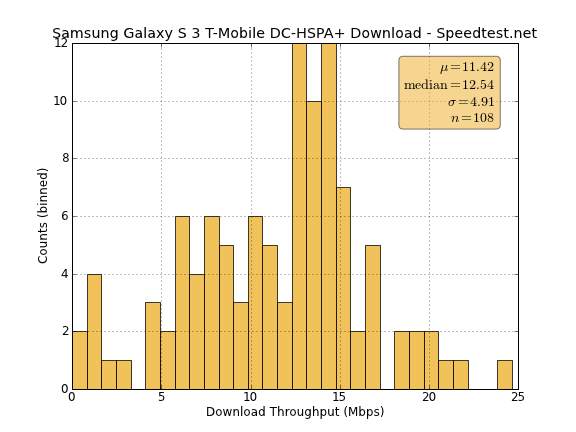
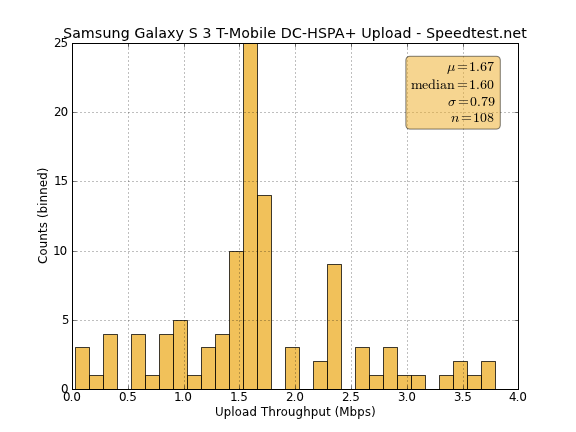
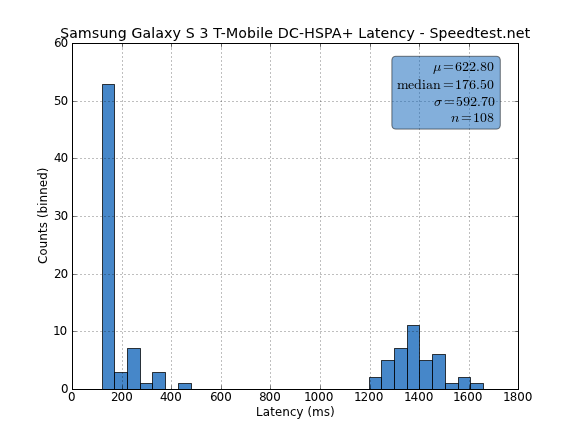
Unsurprisingly DC-HSPA+ is impressively fast on the downlink, with an average of around 11 Mbps and a maximum of just above 20 Mbps. It’s not the kind of performance you’ll get out of LTE (proving somewhat that using subcarriers through OFDMA and other enhancements does pay off), but it’s pretty darn impressive nonetheless. There’s a weird double distribution in latency probably due to setup time coming out of CELL_PCH and setting up the DC-HSPA+ link. Running a test right after this setup yields much lower latency thanks to T-Mobile’s flat IP network, which is why I say it seems to be connection setup related. I’m impressed with how fast T-Mobile’s DC-HSPA+ is in my area, and DC-HSPA+ isn’t a bad interim air interface until the carrier can deploy LTE. You have to applaud T-Mobile for being first to both deploy 64QAM on the downlink (HSDPA 21.1) and deploy DC-HSPA+, two things AT&T still has no intention of doing anytime soon.
I’m headed to an AT&T LTE enabled market as soon as possible to get some AT&T LTE results, but I don’t expect any surprises from that particular device.
WiFi
On the USA SGS3s, I was surprised to find that Samsung hasn’t gone with the on-SoC WLAN and instead implemented BCM4334, mirroring what was done in the international SGS3. BCM4334 we have talked about a lot before, it’s the 45nm version of BCM4330 with added support for 40 MHz channels on 5 GHz, among other lower power features and improvements. Of course, the SGS3s also include NFC (from the incredibly ubiquitous PN544) and BT 4.0 support (from BCM4334).
One of our readers pinged me and let me know that reliable iperf ports are now available on Android and iOS, so I’ll be switching over to using iperf for my main WiFi throughput testing instead of the 100 MB PDF hosted locally. What I’m looking at is still downstream throughput to the phone, since I wager that’s the direction people care most about. I tested a small number of the phones I’ve got on hand with iperf on the new Buffalo 802.11ac compatible router for comparison. For the purposes of the test I’ll be choosing the fastest WiFi interface possible for the device, eg 5 GHz when supported, 2.4 GHz when not supported.
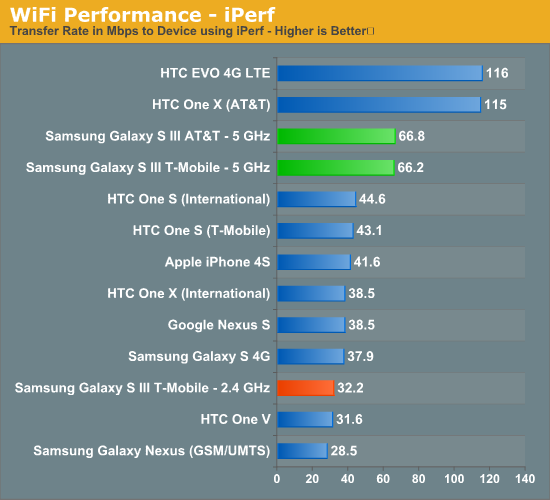
The SGS3s show a PHY of 150 Mbps on 5 GHz with 40 MHz channels, and 65 Mbps on 2.4 GHz with 20 MHz channels. Performance isn’t quite up to the MSM8960 devices like the EVO 4G LTE and One X. I suspect this is due to either limitations on the interface between the SoC and BCM4334, or possibly absence of some other MAC features. Either way I’m glad to see 5 GHz support advancing even more now, to the point where devices are starting to show up with 40 MHz onboard as well.
GNSS
The SGS3 includes onboard GNSS (Global Navigation Satellite System) configuration. In this case, that means GPS with GLONASS. I have no problems getting a fast lock even indoors or in an urban environment, and like other combos with GLONASS you can see those satellites pop into use when GPS signal is weak.
I’m unclear whether the USA SGS3s have gone with Broadcom’s BCM47511 GNSS like what was done in the international SGS3, or whether Samsung is using the MSM8960 onboard GNSS. I need to do more digging to be certain. I suspect this is done on MSM8960, however.
Speakerphone and Sound
Because I’m in the process of moving, I don’t have my sound testing setup complete, nor the sound meter for testing speakerphone. However, I will be able to get that data in the coming week and update with my findings.
Both the AT&T and T-mobile SGS3s use an Audience A2220 for noise rejection using those two microphones (at top and bottom) as well. I need to do my testing here but based on a number of calls I’ve placed already from both I suspect they’ll perform quite well.


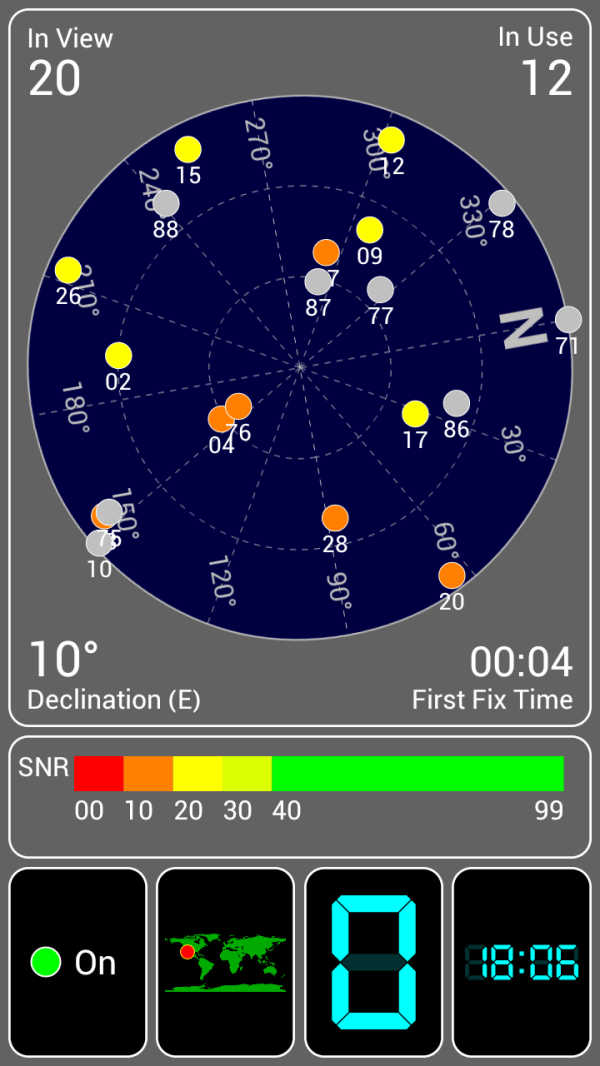
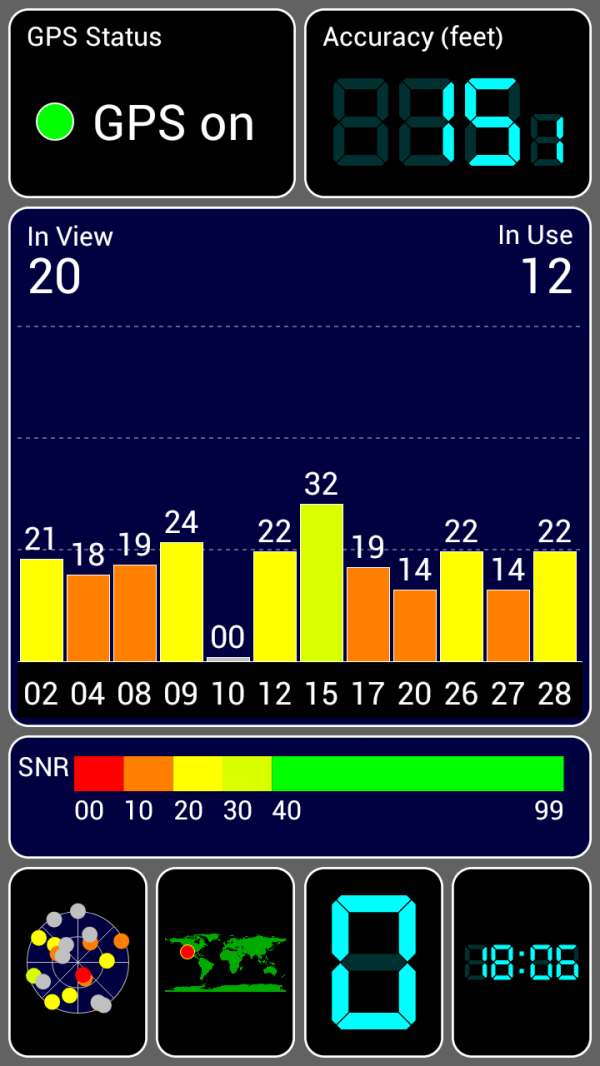








107 Comments
View All Comments
apoorvnaik - Thursday, June 21, 2012 - link
http://support.t-mobile.com/docs/DOC-4448This link says that the phone supports Band I, V, II and AWS.
Does that mean it is a pentaband ?
I'm totally confused by looking at so many different specs. :(
Mnalley95 - Thursday, June 21, 2012 - link
I am currently deciding between the one x and the sgs3, and the two most important factors to me are the battery life and the RAM differences. Nearly every other site has the one x with pretty awfu battery life in their tests, usually with the galaxy nearly doubling the results, but on all of your tests the one x appears fantastic, which is great. All I want is to be able to use my phone at least 12 hours with moderate to heavy use on LTE, so the differing battery results on different sites concerns me. Is there any explanation for this, anyone? Also, the RAM difference could be big in future OS updates, does anyone agree? Which device would be the most future proof? The sgs3 is also easier to hack and will probably have a larger community behind it, which is important. I think I personally like the one X better overall, but if the galaxy beats it in the categories I mentioned I would definitely be happy with it instead. Anyone that cares to share their opinions and answer my questions would be appreciated.Eridanus - Thursday, June 21, 2012 - link
It's a good thing the S3 has an SD card reader, unlike the Nexus.(Am I going to get censured again?)
ItsaRaid - Thursday, June 21, 2012 - link
Brian, both reviews were awesome- how do you cut through the chase and garbage.? Which is the better of the 2? Lets throw away all the crazy stuff, preferences, UI's bells and whistles. I HAVE A Nightmare with a Atrix2 and AT&T. I don't want to duplicate it.Wifi connectivity, receive signal functionality, browser use....lag, forced closes, move up or down on a page, my A2 will freeze and won't flick IP or down on a page. It took over a.Monte to load Annand tech on this phone! Audio output is critical to me, I have a sensory hearing deficit. How does the amount of volume compare to the Atrix2. That's all the good the A2 has...lots of volume and a bright crisp display.
I hope you will respond to this.
Thank you!
Narcopolypse - Thursday, June 21, 2012 - link
The reason S Voice responds so much like Siri is because they both query Worlfram Alpha (an independent system owned by neither company) for their answers. SRI (the company that made Siri) just added in a fake conversation system (20 year old tech) to tell you lame jokes and act like a back talking bitc# when it can't find an answer for you. None of this is new. And yes, Apple has already sued over it and tried to have sales of the GS3 banned in the US.steven75 - Friday, June 22, 2012 - link
Or it could be that S Voice is pretty much a complete clone of Siri from the interface to the functionality. Voice control isn't new, but the complete cloning should be obvious to even the most egregious Android/Samsung fanboy.If we can't agree on that, then we'll probably disagree on other things such as whether 2+2=4.
iCrunch - Sunday, June 24, 2012 - link
Oh come on, I've read multiple reviews and they are 100% consistent in concluding that Samsung's S-Voice doesn't come anywhere close to being as good or accurate or whatever as Apple's Siri. Is my troll/BS detector set to too sensitive or am I picking up some actual trolling here?uhuznaa - Monday, June 25, 2012 - link
Some people seem to think that this needs just voice recognition and a web service to turn to. In fact the real problem here is actually making sense out of what the user said and this is not just a technical problem.I have no idea where Samsung got/bought/licensed the AI here, but I wouldn't be at all surprised if the SRI stuff Apple got its hands on were better.
ProPhotoman - Tuesday, July 3, 2012 - link
I bought a GS3, and the total ram is only 1.6GB .I checked two more in the store, and they are the same. Why is Samsung publishing it as 2gb?cmdrdredd - Thursday, July 5, 2012 - link
A portion is reserved for system usage.